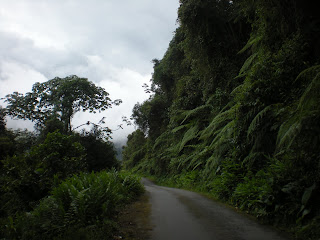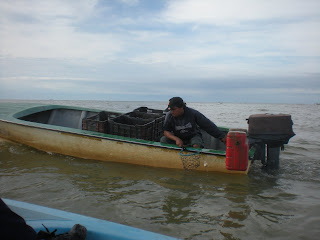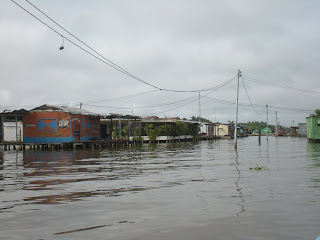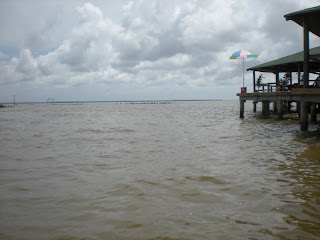There are a LOT of pictures in this one... It was hard to widdle them down.
It's the last weekend in town and as I near the end of this trip I realized I have not seen as much of the country outside of Merida as I would like, so after checking in with our guides and talking it out, five of us who wanted to get out of the city decided to go to Lago de Maracaibo on Friday night. I was actually pretty surprised more people didn't want to do it. It was a national holiday in Venezuela on Friday, not to mention the last weekend, so a lot of people wanted to stay in town and party all weekend. Personally, I feel like you can get drunk and have fun in any city any other time in the world, but when else will we be in Venezuela with these opportunities? Then again, I realized a long time ago I'm in a different place than a lot of the people on the trip, which is fine.
So on Thursday morning I gave a presentation about the Yanomami tribe from the Amazon for my final folklore class, then I was done with college. Spent the day buying the last of the gifts I need, then went out a little bit before early bed.
Friday morning we left town in another one of the jeeps where hardly anyone can face forwards that we took to los llanos. I have discovered the wonders of Dramamine while in this country. Stopped at the grocery store and I thought I'd give everyone a look at this:
They like ketchup here. On everything.
Along the way to the lake we took the scenic route though the mountains, stopping at some waterfalls along the way which are used for canyoning during the dry season. The little specks in this photo are people standing next to the waterfall.
This road took about 4 hours to go on because it was all dirt and washed out in several places. But we got to ride along the summits of the lower Andes for quite a while.
Stopped along the way to walk around a cloud forest for twenty minutes. This is the leaves of one of the tallest trees in the area, which is surprising since you'd think canopy-level trees wouldn't need such big leaves.
The road through the cloud forest.
Huge ferns.
The church in the village of la Azulita. Probably the ugliest I've seen in this country from the outside.
Like I said, Friday was a national holiday so there were lots of flags out, lots of kids not in school and lots of things going on in streets and Bolivar Plazas.
Plaza Bolivar in La Azulita. It was a really nice looking city along the mountain side with lots of nice colorful houses. The flag to the right of Bolivar is the state flag of Merida.
A tiny kitten friend I made in the park outside of the city where we ate lunch.
For lunch we stopped outside of La Azulita and had a picnic in a very green, wet forest next to some natural caves. After lunch we went into the caves and walked around for about 25 minutes. Completely different than any caves you go to as a tourist in the US, where you sign waivers, go down an elevator and get a guide, cement steps and a route... in these ones we just followed the guide who knew where to go and waded in water and bat poop. It was crazy and very cool.
Cave entrance. The walls around the caves are very popular for rock climbing. I went up a little, but without good shoes or a harness it wasn't a great idea. The whole rock wall is covered in amazing natural holds though, and if given the chance I totally would have tried climbing the real thing.
Cave entrance.
Washing our feet off at the other end of the cave exploration.
Another waterfall. In Venezuela, especially on holidays, if you see something you like, you just pull over and start grilling some meat, even when there is very little room on the roadway.
Cocoa trees and seeds.
Coffee beans! Ready to be roasted. Coffee here is dark and strong, but I'm pretty sure that's just the way they brew it. I am so ready to come home and just drink cup after cup of coffee that is reasonably sweet and not a kick in your mouth with every swallow.
This is the port where we left to get to the lake. Maracaibo is the biggest lake in South America, and is surrounded by hot, humid jungle. It's on the ocean side of the Andes and therefore all the humidity that can't make it over the mountains gets left right in this area. It was rainy and cloudy the whole way there, which turned out to be great for animal watching. The next day it was HOT, with the real equator sun shinning right down on us as we rode back to this point.
A family of Howler monkeys in the trees. It was cloudy and my camera does not do good with that kind of light, so its hard to see details, but they're up there! We also saw the little black guys with white faces that are kind of the stereotypical monkey everyone imagines. They ran away too quickly to take pictures, but they looked out at us for a bit. Our guide said he had never seen that particular kind of monkey and he's been doing this for two years.
Approaching the lake.
This is the house we stayed on. Lake Maracaibo is famous for several things: the size, the houses and the lightning. The houses are built on stilts upon the water. There are entire villages like this! The romantic version of the naming of Venezuela is that when the Spanish came here they saw these houses and named the region after Venice, Italy. However its more likely a name derived from the Native people's languages.
The lightning is a phenomena that happens around 300 nights a year. The main hypothesis is that it is caused by weather patterns: with hot air coming from the sea and cold from the mountains crashing in this area, then causing sparks near the lagoons near the lake that are bubbling with methane gas, which sparks lightning that goes upwards from the water itself and never has thunder. All night long from here we were able to watch the silent lightning across the lake.
This is the porch where we slept in hammocks with mosquito nets covering us. It was amazingly beautiful and eerie, with the white linen blowing in the lake breezes all night and the lightning across the lake and the water lapping right below us...
When we arrived we immediately got in our suits and had a sunset swim. The water was just about chest high right here, and didn't ever get too much deeper where we were swimming. It was warm and lovely! We had just seen dolphins jumping near by (this lake is both salt and fresh water, since it's opened to rives as well as the ocean and is a mixing point) and could feel crabs running on our toes while we stood in the water. It was perfect for floating on your back and just watching the clouds above you.
As the sun went down. Right before the lightning started. My camera was not good enough at all to pick that up.
Breakfast the next morning. Pineapple and pancakes.
The next day we took a boat across the lake to Congo, the main village on the water. An hour and a half in a little speed boat across the lake sounds like a long time, but we were able to go SO much faster than anyone can on the roads were because of the "sleeping police", road blocks and other cars going so slow. Also we only make a tiny dent in the whole size of the lake. It's another big-un. The guy on the right is our tour guide and the guy in the back was our boat driver the whole trip.
The front of the boat.
Along the way we ran into this guy fishing crabs. He had a string in the water with chicken heads tied to it and would run the rope along the gas can. As it came out of the water he grabbed any crabs stuck to the chicken heads with the net. It was pretty neat.
The lake looks kinda familiar, fellow north woods folks, no?
This is Congo, the city on stilts. This is the fire station (in case there ever wasn't enough other water around, I guess...)
All the animals live on stilts too. There were dogs and cats and pigs and chickens everywhere.
This is the church and Plaza Bolivar. There is not a town without a Plaza Bolivar.
We went back to camp via the Rio Catatumbo, which goes from Columbia to the Lago de Maracaibo. We passed through the swamps where the lightning itself is happening (though didn't see any in day light) and saw the methane bubbling up from the ground. This area was more wild and had many fewer people. Some houses were along the way though.
That's a bird nest hanging between the two trees.
Back at camp before heading out. It was quite a place.
Back in Merida, we went to the Guinness Book of World Records-Winning Ice Cream shop with the most flavors in the world. They have such flavors as tuna, rice, steak, sugar cane, fresh strawberry, cheese, and lots and lots more.
The flavors list.
Did I mention that the whole trip - food lodging everything - was only 80 USD?


















































